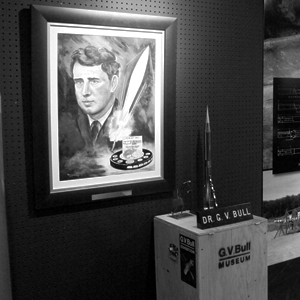

copyright the Chronicle June 4, 2014
by Chris Braithwaite
SUTTON, Quebec — People who end up on the wrong side of history tend to fade quickly from public view. Too quickly, perhaps, because history is not entirely written by its heroes.
Though he was once vital to its economy, Orleans County has no streets or schools or public parks that grateful community leaders have named for Gerald Bull.
And though it must stand as the most disturbingly fascinating place in the region, the headquarters of Mr. Bull’s Space Research Corporation are all but impossible to find. A narrow dirt road runs into the woods off a back road out of North Troy. There’s a For Sale sign outside the rusting gates, whose No Trespassing signs warn off the curious.
Years past, for anyone willing to ignore the signs and risk the wrath of border patrols, an informal museum waited inside those gates. One could find massive cannons rusting in the woods, including a 172-foot-long specimen that must have been the biggest gun in the world. Across an unguarded border in the international compound stood an empty factory that made the artillery shells that landed Mr. Bull in federal prison after Space Research shipped them to South Africa.
The compound was a monument to frustrated genius, to a massive ego, and to international intrigue. In the 34 years since Mr. Bull went to prison, that monument has been lost to us.
But this summer, anyone still curious about the Space Research saga can drive a few miles north and west of the compound to the small Quebec community of Sutton. Part of its charming museum has been devoted to Mr. Bull’s legacy. One can find samples of the missiles he fired from his huge guns in an effort to pioneer an inexpensive way to put small payloads into orbit around the earth.
There are plenty of large-scale photos of the compound in its heyday, and an oral history video that will try the patience of those who haven’t mastered the French language.
What there isn’t is more than a hint that Mr. Bull ever did anything wrong. The display is entirely laudatory.
That’s logical, because it was mounted by Mr. Bull’s children, at the request of Richard Leclerc, president of the Museum of Communication and History of Sutton.
Mr. Leclerc said Monday that he was looking for a subject for the special exhibit the museum mounts every summer when he came across a single photo of the Space Research compound. Intrigued, he contacted one of Gerald Bull’s sons, Robert, and after a meeting with the family the exhibit was arranged.
It includes a brief biography of Mr. Bull that errs only in what it leaves out. It records that he was born in 1928 in North Bay, Ontario, and that he left the University of Toronto at 23 with a doctorate in aerophysics.
We learn that at 36 he was named director of the Space Research Institute at McGill University in Montreal, became president of Space Research Corporation at 41, and at 45 was granted U.S. citizenship by an act of Congress.

At 52, the biography continues, “after a somewhat forced plea bargain,” Mr. Bull was incarcerated for export violations at the federal penitentiary in Allenwood, Pennsylvania.
What the biography doesn’t say is that the violation was the export of thousands of artillery shells to South Africa, then an international pariah because of its apartheid policies, and the subject of strict U.S. and U.N. arms embargoes.
That four-month jail term, according to the biography, “resulted in the bankruptcy of the SRC group of companies, which employed 1,200 people at the time.”
At 62, the biography concludes, Mr. Bull was deceased in Brussels, Belgium. It does not mention that he was assassinated in the corridor outside his apartment, or that his killing, though still unsolved, is widely attributed to the Israeli secret service.
That would be because, at the time of his death in March of 1990, Mr. Bull was deeply involved in the international arms business, and assembling the pieces of an enormous cannon he was putting together in Iraq.
Those who continue to honor Mr. Bull, to insist that he was the victim rather than the perpetrator of international intrigue, argue that he sent arms to South Africa with the full knowledge and support of one branch of the U.S. Government, the Central Intelligence Agency, even while he was prosecuted by another.
The story is that he agreed to remain silent on the matter and plead to the offense in return for the promise that he would only pay a fine. It is undeniable that he was deeply shocked by the brief sentence imposed in federal court in Rutland, that he tried to withdraw his plea and take the case to trial, and that the court did not permit him to do so.
Whatever Gerald Bull’s place in history, his tale is worth telling, his misadventures worth documenting, and Sutton’s volunteer-run museum has done a workmanlike job with the resources available to it.
Mr. Leclerc, its president, said the exhibit may move even closer to the Space Research compound on a permanent basis. The Bull family and the community of Mansonville, just across the border from North Troy, are discussing moving the exhibit there on a permanent basis, he said.
But for the moment, the Bull artifacts can be seen in Sutton on Saturdays and Sundays from noon to 4 p.m. through October 26. The museum is at 32 rue Principale Sud.
contact Chris Braithwaite at [email protected]
For more free articles from the Chronicle like this one, see our Featuring pages. For all the Chronicle’s stories, pick up a print copy or subscribe, either for print or digital editions.







